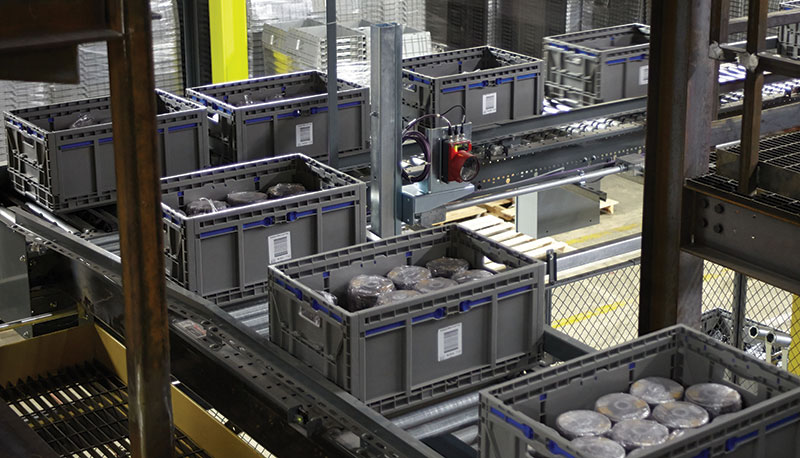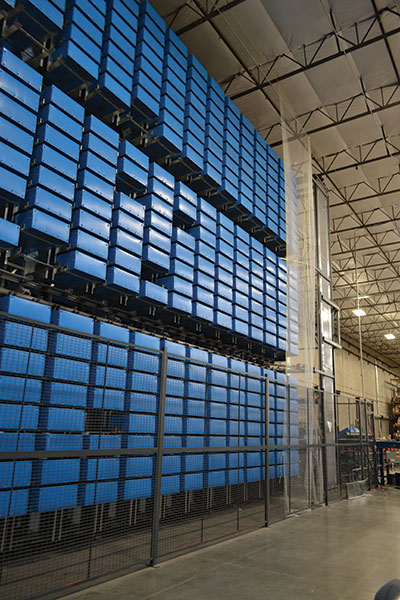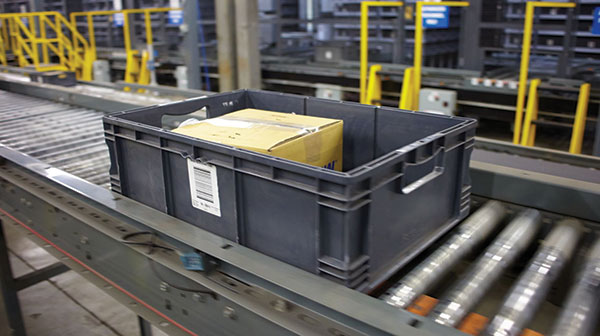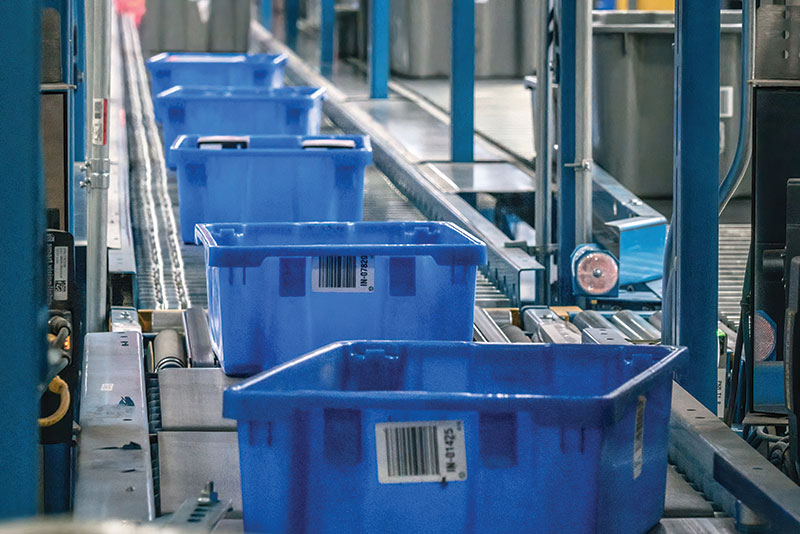Automation Totes: Chameleons in the warehouse
Quickly becoming a centerpiece in DC operations, these totes are designed with flexibility and durability in mind.
The past few years have served as something of a perfect storm for automated systems growth in distribution centers. The rise of e-commerce and far more eaches picking kicked things off, and then the pandemic hit—demand for e-commerce exploded, while the nation began what continues to be one of the largest labor shortages in history. All the while, customer expectations for rapid, on-time delivery done right never slowed. Most distribution centers found themselves struggling to keep up.
Automation is one of the few paths for doing so, and conveyors, automated storage and retrieval systems (AS/RS) and robots have all become essential parts of doing business. In spite of all the progress automation can provide in DC product movement, however, none of it would be possible without totes and containers built to withstand the ride.
“Automated containers are an area of growth in materials handling, especially with the growth of automated DCs and warehouses,” says Bob Petersen, vice president of marketing at ORBIS Corp. “The surge in e-commerce has pushed companies with DC operations to add in more automation to keep up with the high volume of orders with tight cycle times.”
Only a few industries do not need this high-level automation and accompanying totes. “We’re in more than 70% of Fortune 500 company operations,” says Ken Beckerman, president of Flexcon. “Our customers include the medical, manufacturing and dot.com industries—really any type of industry today.”
Today, those totes are often customized to the DC’s operations, the tote manufacturers partner closely with their clients to design just the right sizes, dimensions, materials and more.
Such was the case a couple of years ago when Rochester Drug Cooperative (RDC) reached out to Flexcon. When experiencing lost time and profits due to an unexpected change in tote sizes brought one of the company’s DC’s to a grinding halt, RDC looked for a solution. With plans to open a new DC in the near future, RDC asked Flexcon to design totes specific to the drug company’s operations, ensuring the totes could work seamlessly in the DC’s automated systems.

In this fashion, RDC could depend on the fact that its robotics systems could always handle the DC’s totes. Additionally, with the mold in hand, RDC could ensure a surplus of totes was always available to handle extra volume or future expansion of operations.
Today’s customized totes
Beckerman says that increasingly, automated totes are the most important piece in automated systems. “We’re seeing more demand for totes that can do their own thing, without human contact,” he says. “The specs for customized totes are getting tighter and tighter.”
The objective, he says, is to have the tote adapt to the system. “If you make the tote do the work, you get a greater ROI,” he says. “It takes into account the product it’s storing, rather than having the automated systems change. We try to serve as the chameleons in the room.”
Tote maker Akro-Mils implemented this when it partnered with an industrial goods customer designing and building a 1-million-square-foot DC. Using an AS/RS to move thousands of items throughout the DC, the client needed a specially designed tote that would afford them consistency and utility.

With several hundred thousand individual storage tote locations and more than 1 million storage compartments, the task was more than what an off-the-shelf tote could handle. Akro-Mils’ engineering team designed several tote options for the customer to consider using 3D printing technology.
After testing prototypes, the partners selected a design and then moved onto selecting the type of raw materials needed. The final product—known as the multi-lode tote—features cups and dividers that DC employees can attach and remove quickly, as needed. This affords the client the flexibility it needs, along with reliability to move products quickly and securely throughout the massive AS/RS. The collaboration was successful enough that Akro-Mils will produce more for future expansion.
In another example, Flexcon had a customer looking to lower the cost of meeting stringent fire suppression requirements. “We were able to use materials that lowered their fire risks and met their fire rating specs,” says Beckerman. “They still needed suppression equipment, but this extra design element saved them millions of dollars.”
Beyond customization
Some aspects of customization are universally important, says Ed Granger, director of sales for Quantum Storage Solutions, including designing totes that are flat on the bottom and are proportionate in length, width and height. “This ensures that they’re stable as they move through the systems around corners and in loops,” he explains. “The length must be at least equal to the height.”
Dimensional consistency ensures reliable performance, says Petersen. “This reduces system downtime associated with inconsistent packaging design,” he says. “Unlike fiber corrugated boxes, reusable plastic containers are precisely molded to interface seamlessly with all types of automation, from mini-load systems to conveyors, robotics and full automation.”
Durability is another hallmark of totes designed with automation in mind, adds Granger. “These can be rough handling environments,” he explains. “They sometimes come down chutes and have a rough landing, bins can crash into each other, and sometimes they fall. They must be tough enough to withstand all that.”
Petersen concurs. “These all-plastic totes are designed to replace single-use boxes that can easily get crushed, damaging valuable product,” he says.
When the environments are particularly demanding on the totes, makers can work with the materials to come up with heavy-duty options. “In these cases, we can enhance the strength of the bins by adding special components to the resin,” says Granger. “This is key to protecting products.”

Granger mentioned one particular customer who was experiencing a good deal of product damage. “We visited their operations to observe what was happening,” he explains. “Their bins were taking a lot of punishment. We designed resin that made them stronger and less brittle so they could withstand the impact of their operations.”
Flexcon is working with a new moldable resin that is five times more durable than standard resin, says Beckerman. “For heavy weight or heavy use situations, the totes prevent cracking and damage,” he says. “These are ideal for those with a need for high capacity.”
Additional features you can find in automated tote design, according to Petersen, include “generous internal value, smooth walls that ensure accurate reads from sensor and vision systems, drain holes and reinforced container bottoms.”
Granger says he sees a good deal of demand for lids, too. “This keep products from moving around,” he says. “It also helps when bins reach their destination, so employees can stack them up. By having the ability to go up, companies can save a good deal of space on the DC floor.”
Test before buying
With expensive, high-tech automation that requires such customized designs, all of the automated tote makers agree that testing before investing in new totes is critical. “We always advise our customers to send us samples of their products to put the potential bins through a trial,” says Granger. “We want to make sure the bins can withstand their unique processes.”
If the test bins don’t hold up on the durability scale, for instance, Quantum can add to the resin and shore them up. “This adds to the cost, so we want to make sure it’s necessary,” he says.
While customers might be impatient to get new totes into their systems, taking this extra testing step can lead to a big cost savings. “We’re very liberal with our samples because when you get the design right, the ROI is high,” Granger points out. “We don’t want to put the wrong totes into the field and then have to take it back and start over again.”
Petersen agrees with the wisdom of testing. “It’s critical for integrators and packaging providers to collaborate early in the process, as the system is being designed and planned,” he says. “Every automated system is unique and has different container requirements. This collaboration ensures the right tote is selected and integrates well into the system. It can be costly and time-consuming to retrofit your packaging after implementation.”
When testing is not part of the equation, the costs can rack up quickly due to myriad issues. These include damaged products, wasted DC space, increased distribution costs, robotics malfunctions, injured workers due to tote splintering, and more, according to Flexcon.
“There’s a lot of responsibility riding on your totes,” says Beckerman. “The automated systems don’t have much tolerance for the wrong containers, so it’s critical to design and implement the right container for the right job.”













